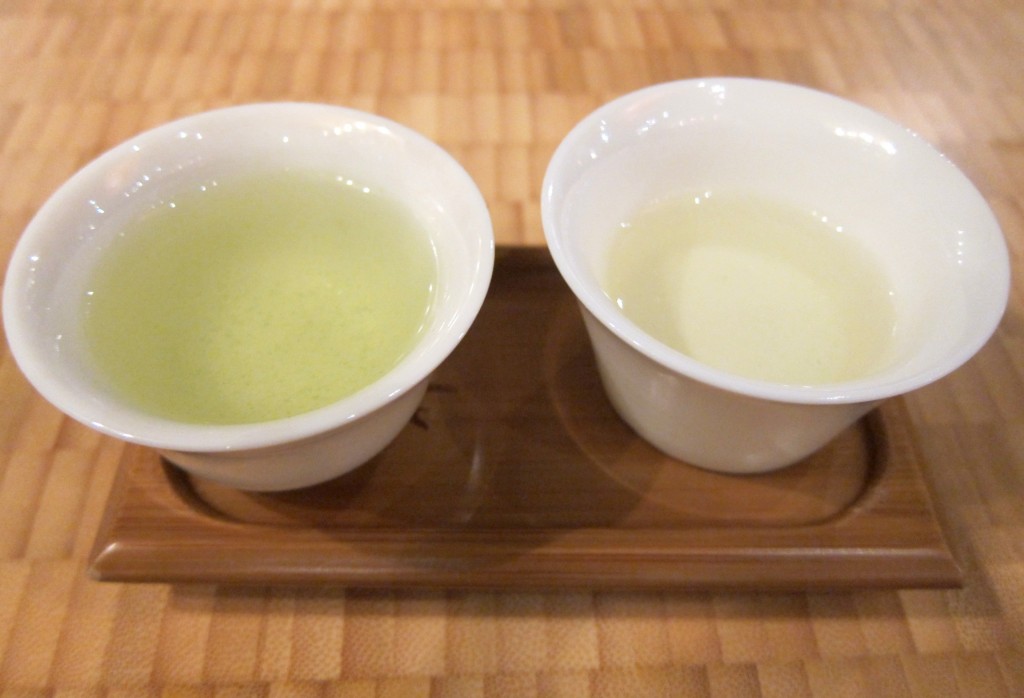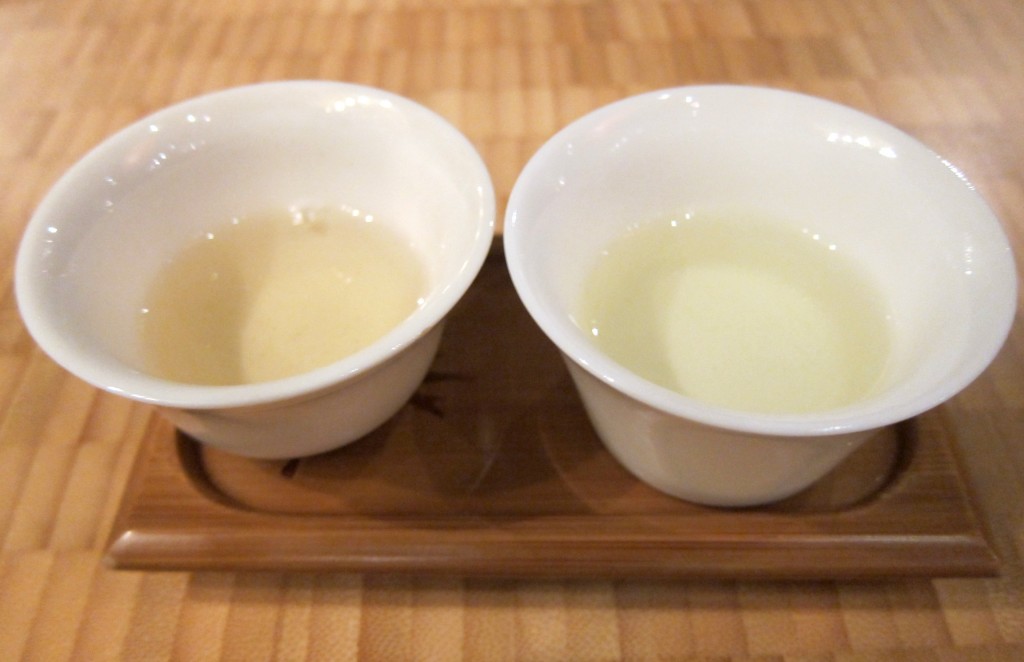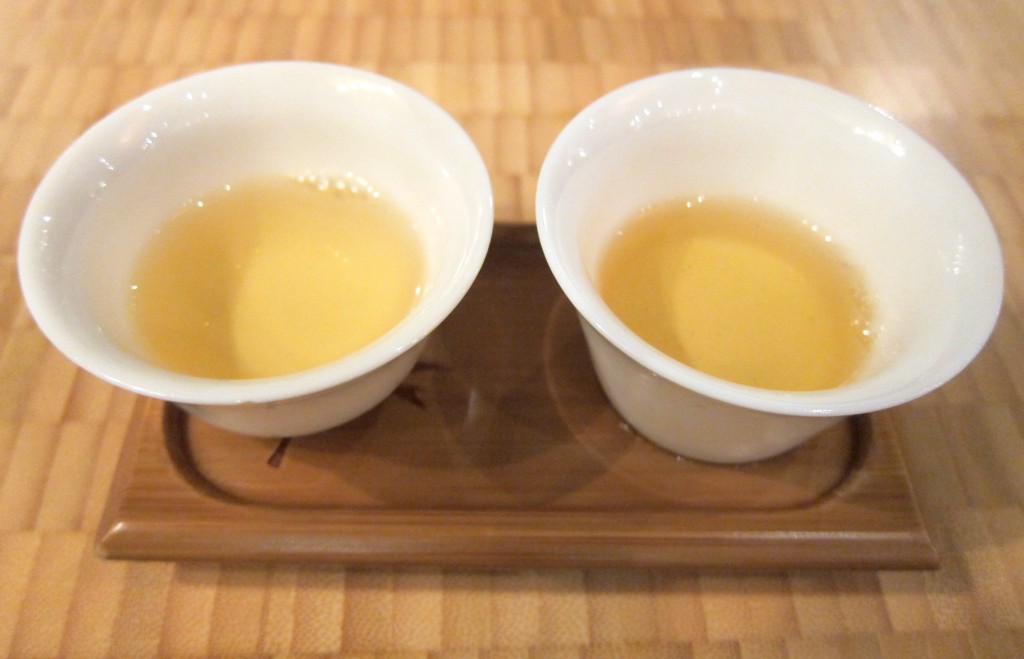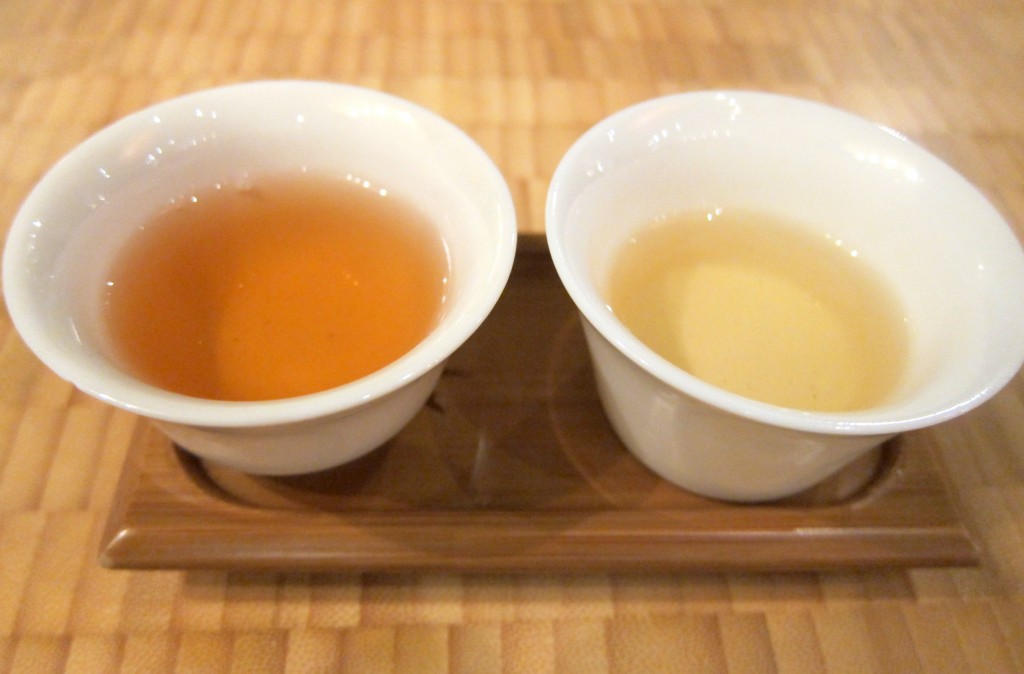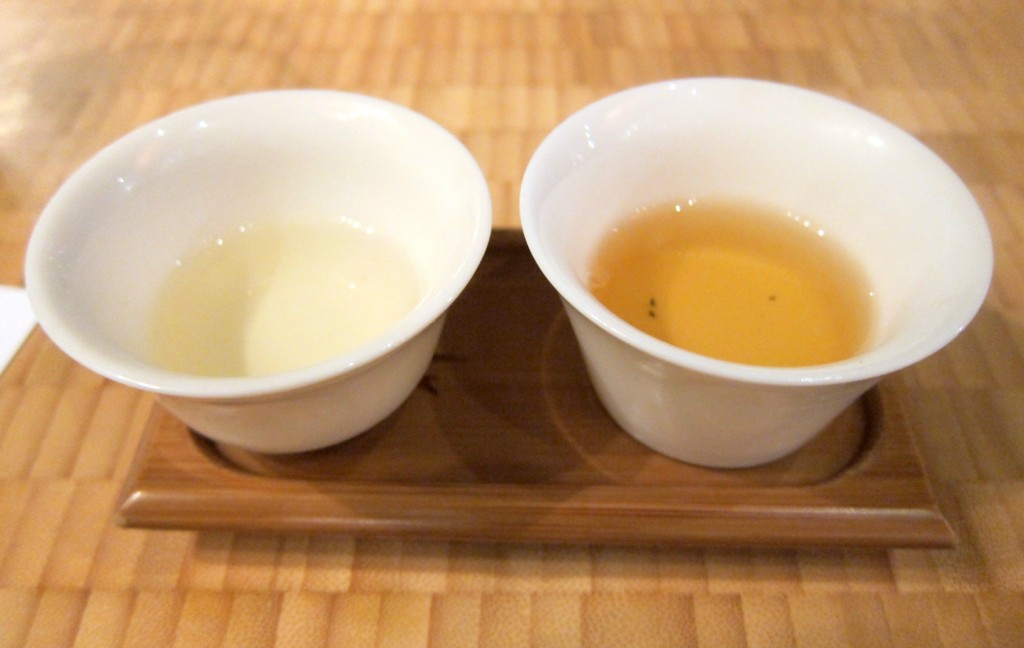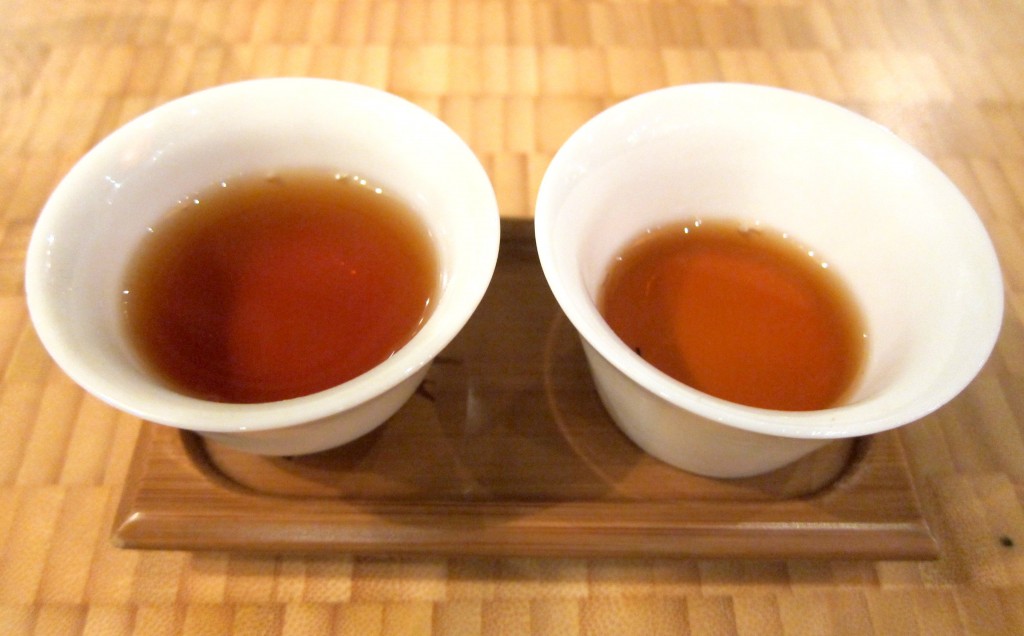Last week Eons ago I wrote Part I, which was an overview of the event’s atmosphere, to publish on The Daily Cal.
Since the beginning of this semester I have been terribly slacking in literally everything with the excuse of work. I haven’t been drinking tea or eating food (reviewable-material food, that is. I’ve been eating at places that I either don’t want to write about or have already written about). My day in the office goes like this: pull hair out, silently scream of quitting, get one or two things on the to-do list done, feel exhausted, go home. Home is really just an office with a shower and a bed, but . Writing was out of the question. However, when Winnie personally talked to me about the tasting event, I felt honored. Writing just felt right again.
Enough dwelling on feelings and atmospheres, though. This recap is only about the teas, 7 pairs in total, which I had to refrain from describing in the Daily Cal article.
1. Gyokuro & Okutani Sencha
Both are green tea from Uji, Japan. The okutani sencha is partially shaded, whereas the gyokuro is fully shaded (by straw, depending on the time of the day) to increase the amount of chlorophyll in the leaves.
The panel described the gyokuro as “edamame”, “nutty, “the taste of the tip of a pistachio nut right beneath its skin” (David Grega), “corn”. Personally, I think it’s smoother and more profoundly resembles seaweed, whereas the sencha veered a bit stringent, although by smell they’re nearly indistinguishable.
Almost everyone preferred the gyokuro. Full shading wins. (Of course!)
2. King’s Tieguanyin & Bio-organic Tieguanyin
Both are oolongs from China.
King’s Tieguanyin: smokey aroma, tastes sweet and grainy like pear, with a hint of “lavender” and “corn” according to the panel.
Bio-organic Tiaguanyin: harvested from the “oldest T. mountain” – what I jotted down in my notes, which I now can’t remember if I meant to say “Tieguanyin mountain”, which doesn’t exist – but the point is it’s left to the wild with plenty of fog and clean air. The tea is extremely fragrant, a mixture of white flowers (orange blossoms, Japanese apricot blossoms, maybe some jasmine). The funny thing is you don’t even have to know that those flowers are white – when the aroma caresses your nasal passage, the white color appears (I’m not making this up). Our olfactory system is a funny thing. With that said though, the King’s Tieguanyin leaves a more long-lasting impression.
3. Taiwan Beauty & Honey Jialong
Both are Taiwanese oolongs. Both are strongly oxidized, exquisite and rare, but fairly known to Teance regulars (we are a lucky bunch, I know). Both can be described as “sweet”, but Taiwan Beauty is sweeter than Honey Jialong. In fact, one of the panelists compared the Taiwan Beauty to sweet wine, with notes of “ripe rose petals” “essence of strawberry” and “marmalade”, whereas the Honey Jialong was “clove”, “passion fruit” “dried cinnamon” and “sandal wood”. However, the Honey Jialong’s smell profile is different from its taste profile, and when cooled, it’s actually smoother than the Taiwan Beauty. To Ryan Tovey, a professional beer crafter, the Taiwan Beauty “nailed the balance” between seaweed, mushroom and flowers.
4. Dowry Tung Ting (18 years old) & Charcoal Tung Ting
Both are Taiwanese oolongs, fairly strongly oxidized, crafted by the same person, although the Dowry one is 18 years older (a dowry gift to the tea master when she got married) and re-roasted every year.
The beer crafters on the panel threw in some interesting comparisons for the Dowry: “pizza sauce”, “dried tomato”, “dried oregano”, “dried meat” and “butternut squash” (i.e., many “elements of comfort”). Someone mentioned “single-malt scotch”. Personally, the Dowry brought to mind hints of toffee, burnt caramel (like creme brulee), and the skin of walnuts. In comparison, the Charcoal has a more gentle, sweeter profile: vanilla, oak, cinnamon stick, peanut brittle. It was also more fragrant than the Dowry.
5. 23-Year-Old Foot-Rolled Tieguanyin & 10-Year-Old Tieguanyin (Extinct Style vs. Modern Style)
Now before we go into details, I know that “foot-rolled” can sound a little questionable. However, the technique of oxidizing the tea leaves by stepping on them is not all that different from stomping on grapes, and foot-rolling produces tighter curls, hence the flavors are more packed in. This method is no longer used, though. Unfortunately.
This 23-y-o foot-rolled Tieguanyin was only left in storage without re-roasting every year. This tea surprised me the most among the 14 teas we tasted tonight. All Tieguanyin that I’ve had, regardless of the level of roastedness (low, medium, or high) and age, have a distinctive, unmistakable Tieguanyin profile: smokey, clover-like, sturdy. The 10-y-o Tieguanyin is like that: “fennel”, “sauerkraut” (the beer crafters tend to use bolder food imageries than the wine sommeliers), “warm spice smell” were the panelists’ description. The foot-rolled Tieguanyin is a world difference: it does NOT taste like Tieguanyin. To me, it was wet moss; to Ryan Tovey, it was a “balance between the sweetness of guava and the savoriness of shiitake”; to Nissa Suteja (one of the wine sommeliers), it was “guava paste”, “apricot”, the “overriped fruitiness of fallen fruits”. It was old and alluring like the damp, dusty wood furniture in grandfather’s home. Shawn Johnson described it in the most vague but possibly most encompassing way of us all: the 10-y-o is a stroll through the grass, whereas the foot-rolled is the feeling you get when you “climb to the top of a tree and watch the sunset”. We all laughed in agreement.
6. Yellow Branch Orchid Phoenix & Wuyi Cliff Big Red Robe
Both are from old tea trees in China.
Folk legend: the mother of a high official centuries ago got really sick, so the official prayed to the tea tree (near his house, perhaps?), and took off his red robe (garment for court meetings that signifies his status) to put on the tree as an offering. Hence tea from that tree (and its relatives) became known as the Big Red Robe (Da Hong Bao) oolong. My notes failed to include the ending of the story, but I guess it must have ended well.
The Yellow Branch, on the other hand, is named after the unidentifiable yellow branch orchid somewhere in the Phoenix mountain, Guangdong. The tea is produced by the ethnic minority She people, who are credited with the earliest processing of oolong, and it is possibly the oldest type among Phoenix oolongs.
Taste-wise, this pair received very diverse comments because of their complexity, as expected of Phoenix oolongs. For me, the most memorable notes of the Yellow Branch were dandelion and chamomile, whereas the Big Red Robe tasted of sugarless cookie (a little charred, buttery but not sweet) and peanuts.
7. Unknown Aged Puer (late 1970s) & 25-30 -Year-Old Puer
Both are naturally fermented and aged from humidity in Hongkong. Both have high viscosity and very low acidity (the acidity is typically gone after 15 years of aging).
Upon tasting, Maayan Kotschitzky proclaimed that he “had no idea what [he] was tasting” because both were too complex to identify. We all laughed heartily. At this point of the evening, with so many different types of tea acting together, we’re bound to experience that euphoria that makes us a little more poetic – the tea “high”. And it shows.
The 25-30 -y-o: “cedar chips”, “dark gravel”, “wet soil”, “like walking into a cave”, “rack of furniture”, “the dampness of the air after the rain as it transitions into sunshine”, “the crusty bottom of Tartine walnut bread”. Somewhere there was mentioning of childhood memories of rolling in the grass… Overall, I felt that the 25-30 -y-o was like roasted beets, sweeter, greener and wetter than the Unknown Aged one, but I was lost myself.
